| 11 June |
• yesterday • tomorrow |
| Memorial of Saint Barnabas, Martyr |

• John of Saint Facundo
• John of Saint Fagondez
• John Gonzales de Castrillo
• John of Saint Facun
• San Fagondez
Son of John Gonzalez de Castrillo and Sancia Martinez, the oldest of seven children, their first after sixteen years of sterility and frustration; raised in a pious and well-to-do family. Educated by Benedictines at Fagondez abbey at Sahagun. Ordained in 1445. Held several benefices in the diocese of Burgos, Spain, his father obtaining them for him like investments, but John surrendered all but one. Unlike many of his class who took their vocation as a profession, John felt a true call to service and a holy life, and he gave most of the proceeds from his benefices to the poor. Majordomo in the residence of his bishop.
Studied at the University of Salamanca, and then at Burgos. Following a grave illness and major surgery, he became an Augustinian canon at Salamanca, joining on 18 June 1463, and making his final profession on 28 August 1464. Novice-master in the order. Definitor of his province. Prior of the order in Salamanca in 1471.
Noted for his devotion to the Blessed Sacrament; during Mass, he often saw the Host surrounded by light, sometimes had visions of the bodily form of Christ at the moment of consecration. His devotion, and his visions, often led to some very lengthy Masses. Reported to levitate during his prayers. Could read hearts in confession, and became a sought-after spiritual director. Great preacher whose sermons helped change social conditions in Salamanca.
His sermons against sinful living conditions, and in support of the rights and diginity of workers brought him the opposition of some local leaders. A duke at Alba de Tormes hired assassins to stop him, but they recognized John's holiness, and would not touch him, confessed to him, and asked forgiveness. The duke later fell ill, and was healed by John's prayers. Some local women, however, were not so concerned; when he preached against wasting resources on extravagant fashions, some of them threw stones at him in the street.
Miracles were attributed to Father John's intervention, before and after his death. One occurred in Salamanca when a small child fell into a well. The locals made every effort, but could not effect a rescue. They sent for Father John who went to the scene, laid his waistband on stone wall of the well, and prayed that the waters return the child. The well water rose to ground level, floating the child to safety. This incident is depicted in the image of Saint John on this page.
1419 at Sahagun (Saint Fagondez), Léon, Spain as John Gonzales de Castrillo
• 11 June 1479 at Salamanca, Spain of natural causes
• may have been poisoned by a woman whose lover, a nobleman, broke off their relationship after hearing John preach, and for this reason he is sometimes listed as a martyr
• relics in churches in Spain, Belgium and Peru
• 19 June 1601 by Pope Clement VIII
• 28 September 1651 by Pope Pope Innocent X
16 October 1690 by Pope Alexander VIII
• city of Salamanca, Spain
• diocese of Salamanca, Spain
holding a chalice and host surrounded by rays of light
https://catholicsaints.info/saint-john-of-sahagun/
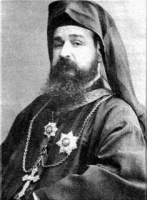
• Choukrallah Maloyan
• Ignadios Maloyan
• Ignatios Maloyan
• Ignatius Maloyan
• Shoukrallah Maloyan
• Shukrallah Maloyan
Son of Melkon and Faridé Maloyan. Studied at the convent of Bzommar-Lebanon where he was ordained on 6 August 1896. Member of the Bzommar Institute. Took the name of Ignatius in remembrance of Saint Ignatius of Antioch. Parish priest in Alexandria and Cairo, Egypt from 1897 to 1910. Assistant to Patriarch Boghos Bedros XII in 1904, but respiratory health problems forced his return to Egypt. Dispatched to the diocese of Mardin to restore order and discipline. Archbishop of Mardin on 22 October 1911, working with the Armenian Catholic minority. Encouraged the devotion to the Sacred Heart.
At the outbreak of World War I, Armenians in Turkey, especially Christians, became the target of persecutions. On 30 April 1915 a group of Turkish soldiers surrounded the Armenian Catholic Bishopric and church in Mardin, claiming it was used to hide weapons. On 3 June 1915, Turkish soldiers arrested Bishop Maloyan along with many other Armenian Catholic priests and laymen. In court, chief of the police Mamdooh Bek ordered bishop Maloyan to convert to Islam; the bishop declined, and was beaten, tortured, chained, and imprisoned. On 10 June 1915, Ignazio and over 400 other Christians, including fourteen priests, were force marched into the desert. When they stopped, bishop Ignazio celebrated an impromptu liturgy with scraps of bread; the group was then murdered. The bishop was the last to die. At the last minute, Mamdooh Bek again demanded that Ignazio convert to Islam; when the bishop refused, Bek shot him.
18 April 1869 at Mardin, Turkey
• shot to death on 11 June 1915 by Mamdooh Bek at Zerzevan Castle, Çinar, Diyarbakir, Turkey
• his body is reported to have radiated light for three days after his death
7 October 2001 by Pope John Paul II
I shall live and die for the sake of my faith and religion. I take pride in the Cross of my God and Lord. - Blessed Ignatio to the final demand that he abandon Christianity
https://catholicsaints.info/blessed-ignazio-maloyan/

Bernabé, Joseph
Levite Jewish convert, coming to the faith soon after Pentecost, taking the name Barnabas. Though not of the chosen Twelve Apostles, Barnabas is mentioned frequently in the Acts of the Apostles, is included among the prophets and doctors at Antioch, and is considered an Apostle. Companion of Saint Paul who introduced him to the Apostles. Like Paul, Barnabas believed in the Church's mission to Gentiles, and worked with him in Cyprus and Asia, but split with him over a non-theological matter. Evangelized in Cyprus with Saint Mark. Founded the Church in Antioch. Subject and possible author of some apocryphal works. Martyr.
Cyprus as Joseph
• martyred in c.61 at Salamis
• at the time of his death he was carrying a copy of the Gospel of Saint Matthew that he had copied by hand
son of encouragement; son of consolation
• against hailstorms
• Antioch
• Cyprus
• invoked as peacemaker
• Marbella, Costa del Sol, Spain
• Marino, Italy
• ax
• lance
• middle-aged bearded apostle, often bearing a book or olive branch
• standing on or near a pile of stones while holding a book
• stones
• with Saint Paul
• books
https://catholicsaints.info/saint-barnabas-the-apostle/
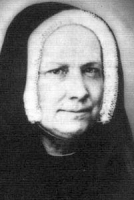
Paola Frassinetti
Only daughter of John and Angela Frassinetti, she was raised in a pious family; all four of her brothers became priests. Paula's mother died when the girl was nine years old. In need of a substitute mother, Paula turned to Our Lady.
One of Paula's aunts moved in to help with the family, but she died three years later, and at age twelve, Paula took over as homemaker. Because of the endless chores at home, Paula was not able to attend school. However, each night her brothers would pass along what they had learned that day, her father filled in the gaps, and Paula actually had a good education. She attended Mass daily, and prayed her way though all of her work.
At age 20 she developed respiratory problems, and moved in with one of brothers, a village priest in Quinto, Italy. When she recovered, Paula, with her brother's help, opened a parochial school for poor girls in the area. In 1834, with a group of like-minded young women, she founded the Sisters of Saint Dorothy (Frassinetti Sisters), a congregation dedicated to educating poor children. They soon opened foundations in Italy, Portugal, and Brazil, and were noted for their work with the sick in the cholera epidemic that ravaged northern Italy in 1835. The Sisters received papal approval in 1863.
3 March 1809 at Genoa, Italy
• 11 June 1882 of pneumonia following a series of strokes
• entombed at Saint Onofria, the Dorothean motherhouse in Rome, Italy
• body found incorrupt in 1906
11 March 1984 by Pope John Paul II
sick people
https://catholicsaints.info/saint-paula-frassinetti/
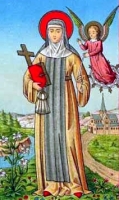
• Aleydis the Leper
• Aleydis of Scharembeke
• Adelaide, Alice, Alix, Adelheid, Aliz
At age seven Aleydis was sent to the Cistercian convent of Camera Sanctae Mariae to receive an education; she stayed the rest of her life. In adolescence she developed leprosy and was isolated from the community; the spirit with which she bore her illness served as an example to the rest of the community. While in isolation, Aleydis developed a deep devotion to Real Presence in the Eucharist, but was unable to drink from the cup due to the danger of contagion. As the disease progressed, she became blind and paralyzed. Visionary; given to ecstasies, and a visit from Christ to assure her of the complete Communion of the Eucharist. Was given the gift of healing of others, but not herself.
12th century at Schaerbeck, Belgium
sunrise Saturday 11 June 1250 of natural causes
• on 1 July 1702 Pope Clement XI granted the monks of the Fuliensi Congregation of Saint Bernard permission to celebrate her feast
• cultus extended to the entire Cistercian Order in 1870
• cultus extended to all of Belgium in 1907 by Pope Pius X (cultus confirmed)
• blind people
• paralyzed people
https://catholicsaints.info/saint-aleydis-of-schaerbeek/
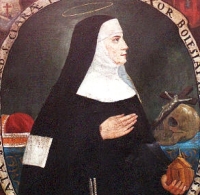
• Helen of Hungary
• Helena, Iolantha, Joheleth, Jolanda, Jolanta, Jolenta, Yolanda
Born a princess, the daughter of King Bela IV of Hungary and Maria Laskaris. Niece of Saint Elizabeth of Hungary, grand-niece of Saint Hedwig of Andechs, and younger sister of Blessed Cunegund of Poland, who raised her. Married to Duke Boleslas V, the devout prince of Kalishi, Pomerania; mother of three. Franciscan tertiary. Founded a Poor Clare convent in Gnesen, Poland. Widowed in 1279. She, one of her daughters, and Cunegund retired to a Poor Clare convent Cunegund had founded in Sandeck. Just before her death, Helen became superior of the convent she had founded in Gnesen.
c.1235 in Hungary
11 June 1298 at Gnesen, Poland of natural causes
26 September 1827 by Pope Leo XII (cultus confirmed)
https://catholicsaints.info/blessed-helen-of-poland/
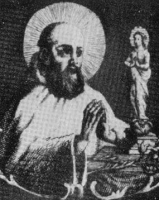
Parisio
Camaldolese monk at age 12 at the monastery of Saint Michael's. Hermit. Priest. Chaplain and spiritual director of the Saint Christina convent of Treviso, Italy in 1191; he served there for 72 years. Cared for the spritual needs of pilgrims and the sick at the All Saints Hospice at his monastery. Miracle worker. Had the gift of prophecy.
1160 at Treviso or Bologna, Italy (records vary)
• 11 June 1267 of natural causes
• relics enshrined in the cathedral of Treviso, Italy
25 November 1268 by Bishop Alberto Rich of Treviso, Italy, which was a valid procedure at that time
https://catholicsaints.info/saint-parisius/
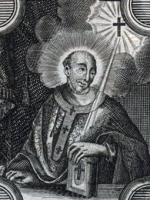
Bardone, Bardon
Benedictine monk at Fulda, Germany. Abbot of Werden Abbey, Essen-Werden, Germany in 1029. Abbot of Hersfeld Abbey, Hesse, Germany in 1031. Archbishop of Mainz, Germany in 1031. As monk, abbot and bishop he was known for his simple, ascetic life, his charity to the poor, the gift of prophecy, and his care for animals.
982 in Oppershofen, Germany
1053 of natural causes
https://catholicsaints.info/saint-bardo-of-mainz/
Known as a pious and intelligent youth. Premonstratensian monk. Canon of the Premonstratensian monastery in Vicogne, France. Chosen abbot of his house in 1513, he refurbished the monastery, spent his nights in prayer, and was known for his charity and aid to the area poor; he served as abbot for 37 years. Advisor and confessor to Emperor Charles V. Declined the bishopric of Arras, France as it owuld have meant leaving monastic life.
1488 in France
1550 in northern France of natural causes
https://catholicsaints.info/blessed-jean-de-bracq/
Kaspar
Premonstratensian monk. Canon of the Grimbergen Premonstratensian monastery in modern Flanders, Belgium. Priest. When Calvinists controlled the region in 1581, Kasper dressed as a layman and travelled from town to town, ministering to covert Catholics in their homes.
16th century Netherlands
17th century of natural causes
https://catholicsaints.info/blessed-kasper-of-grimbergen/
Rimbert
Benedictine monk at Turhout, Belgium. Worked with Saint Ansgar as a missionary to pagan Scandinavia. Bishop of Hamburg-Bremen, Germany in 865 with jurisdiction over Denmark and Sweden. Worked to evangelize the Slavs in his region, and ransomed Christian captives. Wrote a biography of Saint Ansgar.
near Bruges, Flanders, Belgium
888 of natural causes
https://catholicsaints.info/saint-rembert/
Blitarius, Blier
Evangelized in France with Saint Fursey of Peronne, finally settling in Seganne, Champagne where he was known for his life of penance and prayer.
Scotland
• 7th century France of natural causes
• relics burned by Calvinists in the 16th century
https://catholicsaints.info/saint-blitharius-of-seganne/
Bishop of Naples, Italy in 359, but spent much of his service in exile for having defended the Nicene Creed against Arian rulers. Martyr.
c.361
13 June 1871 by Pope Pius IX (cultus confirmation)
https://catholicsaints.info/saint-maximus-of-naples/
Ragallach, Regail, Reghuil
Ninth-century monk and then abbot of Bangor Abbey, County Down, Ireland. He led the house during a bleak period of recovery following a series of Viking raids.
881
https://catholicsaints.info/saint-riagail-of-bangor/
Educated at Rheims, France. Benedictine monk at Saint Martin's abbey, Tournai, Belgium. Abbot of the monastery at Marchiennes, France in 1148.
at Tournai, Belgium
1158
https://catholicsaints.info/blessed-hugh-of-marchiennes/
Tochumra of Tuam
A holy virgin venerated in Kilmore, Ireland.
women in labour
https://catholicsaints.info/saint-tochumra-of-kilmore/
Herband, Hereband
Eighth century hermit in Brittany.
in Britain
https://catholicsaints.info/saint-herebald-of-bretagne/
A church in the diocese of Killfenora, Ireland was dedicated to him, but no details of his life have survived.
https://catholicsaints.info/saint-tochumra-of-tuam/
Members of the Knights of Santiago de Castilla. During the re-conquest of the Iberian peninsula from the Muslims by Christian forces, in a period of truce between the armies, the group was allowed to leave the Portuguese camp to hunt. Near Tavira, Portugal, he and his companions were ambushed and killed by a Muslim force. Making a reprisal attack, the Portuguese army took the city of Tavira. The murdered knights were considered to be martyrs as they died in an action defending the faith. They were –
• Blessed Alvarus Garcia
• Blessed Beltrão de Caia
• Blessed Damião Vaz
• Blessed Estêvão Vasques
• Blessed Garcia Roiz
• Blessed Mendus Valle
• Blessed Pedro Rodrigues
• 1242 outside Tavira, Faro, Portugal
• relics enshrined under the altar of Saint Barnabas in the Church of Our Lady, Queen of the Angels (modern Santa Maria do Castelo) in Tavria
https://catholicsaints.info/martyrs-of-tavira/
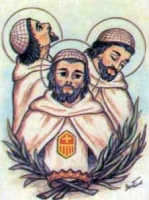
Three Mercedarian lay knights who worked to ransom Christians enslaved by Muslims. During the 7th Crusade, a plague swept through the Christian army and these knights volunteered to work with the sick. During this work they were captured by Muslims and ordered to convert to Islam; they refused. They were tortured, taken to Damietta, Egypt where they were murdered for their faith. Martyrs.
thrown from a tower in the mid-13th century in Damietta, Egypt
https://catholicsaints.info/mercedarian-martyrs-of-damietta/
• Our Lady of Mantara
• Agnes of Hungary
• Maria Rosa Molas i Vallvé
• Maria Schininà Arezzo
• Stephen Bandelli
CatholicSaints.Info Portable Edition